The Personal Navigation Devices Market is estimated to be valued at USD 3.6 billion in 2025 and is projected to reach USD 8.0 billion by 2035, registering a compound annual growth rate (CAGR) of 8.2% over the forecast period.
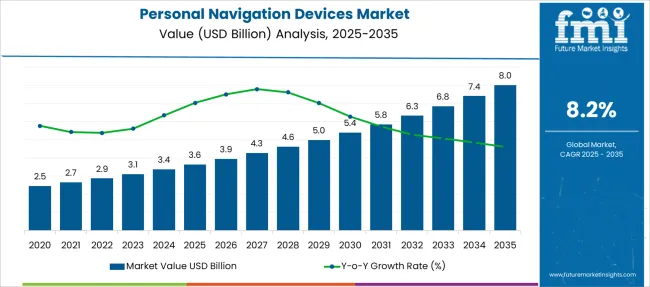
| Metric | Value |
|---|---|
| Personal Navigation Devices Market Estimated Value in (2025 E) | USD 3.6 billion |
| Personal Navigation Devices Market Forecast Value in (2035 F) | USD 8.0 billion |
| Forecast CAGR (2025 to 2035) | 8.2% |
The personal navigation devices market is growing steadily as vehicle owners increasingly demand advanced navigation solutions for improved driving experience and safety. Growing adoption of mid-premium passenger vehicles has driven the integration of sophisticated navigation systems that offer real-time traffic updates, route optimization, and user-friendly interfaces. Technological progress in GPS accuracy and connectivity features has enhanced device reliability and convenience.
Additionally, the rise of smart mobility and connected car ecosystems has encouraged manufacturers to equip automobiles with integrated navigation devices. Consumer preference for personalized and seamless navigation experiences continues to expand, supported by advancements in voice recognition and cloud-based mapping.
The market outlook remains favorable as automotive manufacturers and aftermarket suppliers invest in navigation technologies to meet evolving consumer expectations. Segment growth is expected to be led by mid-premium passenger vehicle navigation systems and the automobile application sector.
The market is segmented by Type and Application and region. By Type, the market is divided into Mid-Premium Passenger Vehicle, Commercial Vehicle, Entry-Level Passenger Vehicle, and Luxury Passenger Vehicle. In terms of Application, the market is classified into Automobiles, Smartphones, and Tablets. Regionally, the market is classified into North America, Latin America, Western Europe, Eastern Europe, Balkan & Baltic Countries, Russia & Belarus, Central Asia, East Asia, South Asia & Pacific, and the Middle East & Africa.
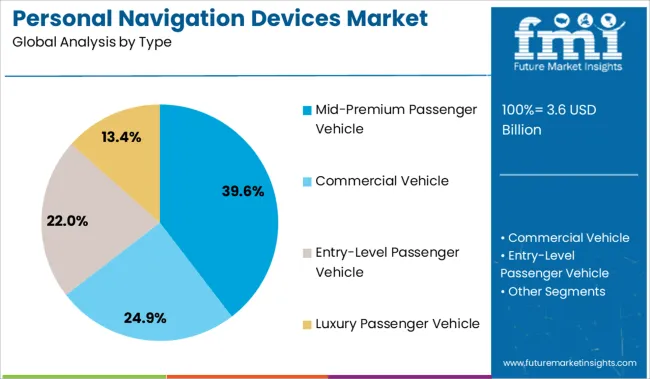
The mid-premium passenger vehicle segment is projected to hold 39.6% of the personal navigation devices market revenue in 2025, establishing its dominance among vehicle types. The growth in this segment has been influenced by increasing consumer demand for premium features that enhance driving comfort and convenience. Mid-premium vehicles often serve buyers seeking a balance between luxury and affordability, driving demand for advanced navigation systems as standard or optional features.
Enhanced display interfaces and connectivity options tailored for this segment have increased user engagement. Automakers have focused on integrating intuitive navigation devices that align with the vehicle’s overall premium experience.
As more consumers opt for mid-premium vehicles, the segment is expected to continue leading in navigation device adoption.
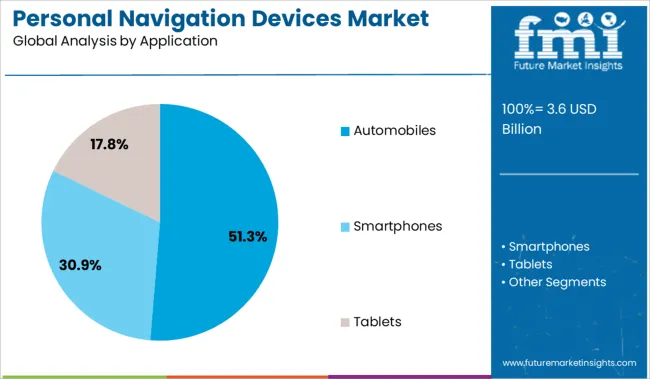
The automobiles application segment is projected to contribute 51.3% of the personal navigation devices market revenue in 2025, positioning it as the largest application sector. This growth is driven by the widespread integration of navigation systems in cars across different price ranges and vehicle types. Navigation devices have become essential for modern vehicles, offering features like real-time traffic alerts, route guidance, and connectivity with smartphones.
The increasing number of vehicles on roads and growing urban traffic complexities have heightened the need for reliable navigation aids. Additionally, aftermarket sales and OEM installations contribute significantly to market growth.
As automobile manufacturers continue to innovate and consumers prioritize convenience and safety, the automobiles segment is expected to maintain its leading market share.
Rise in the usage of smartphones and other smart devices, equipped with navigation system apps, increases the demand for personal navigation systems. Increasing demand from OEMs and after market applications in emerging economies expands the personal navigation devices market share.
Surging awareness and need for location-based devices, for safety, increases the sales of personal navigation devices. Increasing demand for in-vehicle infotainment as well as location tracking services to guide traveling surges the adoption of personal navigation devices.
The growing requirement of navigational devices in the automotive and commercial sectors drives the sales of personal navigation devices. Demand for IoT and cloud-based services to be applied to GPS systems promotes the personal navigation devices market growth.
Manufacturers incorporating safety and security applications, such as the implementation of Advanced Driver Assistance (ADAS) with additional intelligent sensors increases, the sales of personal navigation devices.
Integration of navigation supported by safety and security features in automobiles to avoid thefts and accidents surges the demand for personal navigation devices.
Sales of personal navigation systems are predicted to decline due to feature-related complexity and increased user expectations. Due to frequent GPS system updates, which can be annoying for users, impeding the personal navigation devices market.
The personal navigation devices market size impedes due to high costs associated with in-dash navigation systems. Lack of telecommunication infrastructure in developing economies, resulting in scarcity, hinders the demand for personal navigation devices.
Moreover, the adoption of personal navigation devices hampers due to growing concerns associated with data protection and privacy. Inaccurate location detection and clocks in underdeveloped countries further thwart the personal navigation devices market share.
Technological developments, along with increasing demand owing to rising disposable income of consumers in developing economies escalates the adoption of personal navigation devices.
The implementation of GPS systems in connected cars to provide navigation services for planning of fastest routes and avoiding real-time traffic surges the demand for personal navigation devices.
Using transmit fleet positioning information through onboard units (OBUs) to aid transport operators in detecting logistics performance activities expands the personal navigation devices market share.
Increasing usage of digital maps and surge in advancement and upgrade of software used in GPS tracking devices further propels the personal navigation devices market growth.
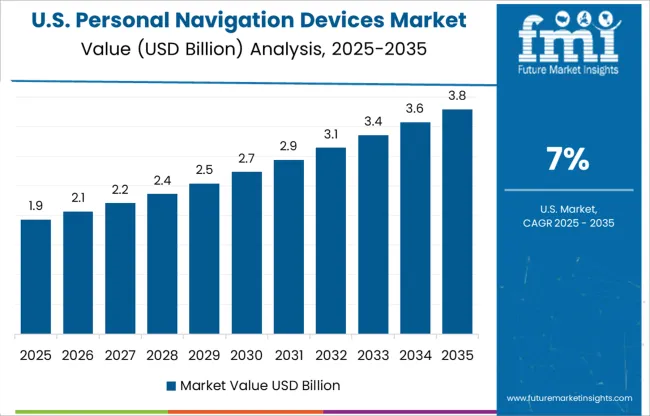
North America holds the highest personal navigation devices market share, with a revenue of 30.5%.
The adoption of technology linking smartphones to in-vehicle systems (IVS) contributes to the global personal navigation devices market growth. High utilization of multi-sensor data acquisition systems for track mapping in the USA surges demand for personal navigation devices in this region.
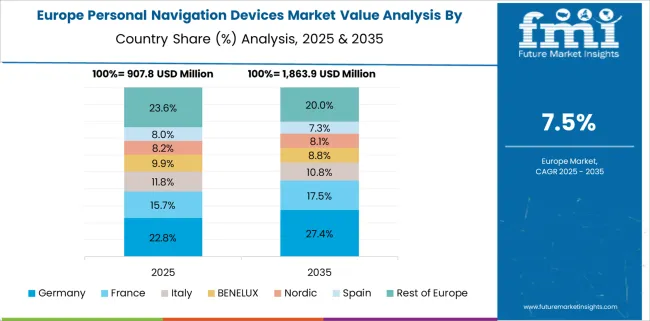
Europe is the second leading personal navigation devices market share, with a revenue of 20.1%.
The strong presence of component manufacturers in this region escalates the demand for personal navigation devices. The growing investments by the governments, along with integration of sophisticated technologies in this region, surges the adoption of personal navigation devices.
The Asia-Pacific is a rapidly growing personal navigation devices market share.
Extreme traffic in major cities of countries like China and India surges the adoption of personal navigation devices. Growth in vehicle manufacturing and increased regulatory limitations in developing countries contribute to the global personal navigation devices market growth.
With the advent of technology, and the fast-paced life, the need for a proper functioning GPS system is essential. In cars or personal smartphones, whether to reach a destination or for safety - being able to be guided to a favorable location is something that every individual deems necessary.
New personal navigation devices market players of the personal navigation devices market share are constantly improving the feedback of their navigation devices to better suit consumer demands.
Certain start-up companies are also contributing to the development of the personal navigation devices market share, namely Agri Info Design, Xono Space Systems, Camera, Point One Navigation, Deep Map, Ushr, Swift Navigation, etc. are offering services such as GPS receiver with real-time kinematics functionality, high definition mapping technology, cloud-based GPS augmentation solution, machine-readable and sensor-agnostic data, 3D maps and navigation, etc.
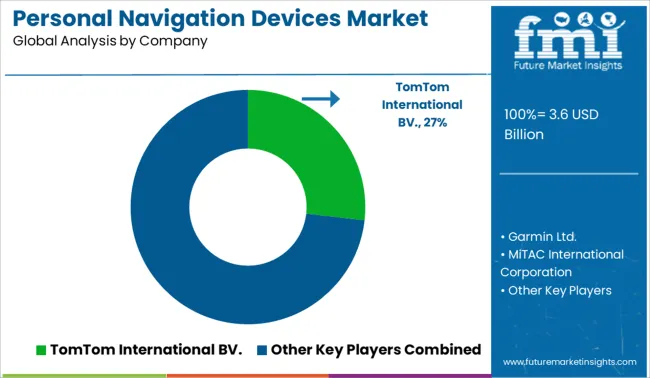
Some of the key participants of the personal navigation devices market are TomTom International BV., Garmin Ltd., MiTAC International Corporation, Magellan GPS, Blaupunkt worldwide, Masternaut Limited, NAVIGON, AvMap Satellite Navigation, Inc., Becker Navigations, TeleNav, Alpine Electronics, Garmin, Pioneer, Continental, Kenwood, SAMSUNG Group, Shanghai Botai Group, Guangzhou FlyAudio, Ouhua Electronics, Skypine Electronics Coagent Electronics S&T, ShenZhenRoadRover Technology, Texas Instruments Inc., Garmin Ltd., Mio Technology Corporation, etc.
Generating the utmost accurate location for people trying to reach their location is the dream for personal navigation device market players. Technological developments and meeting consumer demands are aiding in the personal navigation devices market growth.
| Report Attribute | Details |
|---|---|
| Growth Rate | CAGR of 8.2% from 2025 to 2035 |
| Base year for estimation | 2024 |
| Historical data | 2020 to 2024 |
| Forecast period | 2025 to 2035 |
| Quantitative units | Revenue in USD million and CAGR from 2025 to 2035 |
| Report coverage | Revenue forecast, volume forecast, company ranking, competitive landscape, growth factors, and trends, Pricing Analysis, |
| Segments covered | Type, Application, and Region. |
| Regional scope | North America; Western Europe; Eastern Europe; Middle East; Africa; ASEAN; South Asia; Rest of Asia; Australia and New Zealand |
| Country scope | USA, Canada, Mexico, Germany, UK, France, Italy, Spain, Russia, Belgium, Poland, Czech Republic, China, India, Japan, Australia, Brazil, Argentina, Colombia, Saudi Arabia, UAE, Iran, South Africa |
| Key companies profiled | TomTom International BV.; Garmin Ltd.; MiTAC International Corporation; Magellan GPS; Blaupunkt worldwide; Masternaut Limited; NAVIGON; AvMap Satellite Navigation, Inc.; Becker Navigations; TeleNav; Alpine Electronics; Garmin; Pioneer; Continental; Kenwood; SAMSUNG Group; Shanghai Botai Group; Guangzhou FlyAudio; Ouhua Electronics; Skypine Electronics Coagent Electronics S&T; ShenZhenRoadRover Technology; Texas Instruments Inc.; Garmin Ltd.; Mio Technology Corporation; etc |
| Customization scope | Free report customization (equivalent to up to 8 analysts working days) with purchase. Addition or alteration to country, regional & segment scope. |
| Pricing and purchase options | Avail customized purchase options to meet your exact research needs. |
The global personal navigation devices market is estimated to be valued at USD 3.6 billion in 2025.
The market size for the personal navigation devices market is projected to reach USD 8.0 billion by 2035.
The personal navigation devices market is expected to grow at a 8.2% CAGR between 2025 and 2035.
The key product types in personal navigation devices market are mid-premium passenger vehicle, commercial vehicle, entry-level passenger vehicle and luxury passenger vehicle.
In terms of application, automobiles segment to command 51.3% share in the personal navigation devices market in 2025.






Full Research Suite comprises of:
Market outlook & trends analysis
Interviews & case studies
Strategic recommendations
Vendor profiles & capabilities analysis
5-year forecasts
8 regions and 60+ country-level data splits
Market segment data splits
12 months of continuous data updates
DELIVERED AS:
PDF EXCEL ONLINE
Personal Emergency Response System (PERS) Market Size and Share Forecast Outlook 2025 to 2035
Personal Care Ingredient Market Size and Share Forecast Outlook 2025 to 2035
Personal Protective Equipment Market Size and Share Forecast Outlook 2025 to 2035
Personality Assessment Solution Market Size and Share Forecast Outlook 2025 to 2035
Personalized Immunotherapy Market Size and Share Forecast Outlook 2025 to 2035
Personal Care Appliances Market Size and Share Forecast Outlook 2025 to 2035
Personal Genome Testing Market Size and Share Forecast Outlook 2025 to 2035
Personal Watercraft Jet Ski Market Size and Share Forecast Outlook 2025 to 2035
Personalized Packaging Market Size and Share Forecast Outlook 2025 to 2035
Personalized Toys Market Size and Share Forecast Outlook 2025 to 2035
Personal Care Wipes Market Size and Share Forecast Outlook 2025 to 2035
Personalized Nutrition Market - Size, Share, and Forecast Outlook 2025 to 2035
Personal Watercraft Market Growth - Trends & Forecast 2025 to 2035
Personalized Bakery Products Market Analysis by Product Type, Price Range, Sales Channel, End-User and Region 2025 to 2035
Personal CRM Market Report - Growth & Forecast 2025 to 2035
Personal Care and Cosmetics Microalgae Market - Beauty & Skincare Trends 2025 to 2035
Personalized Medicine Market is segmented by Personalized Medicine Diagnostics, Medicine Therapeutics, and Medical Care from 2025 to 2035
Personal Fitness Trainer Market - Trends, Growth & Forecast 2025 to 2035
Personal Care Packaging Market Analysis by Application, Packaging Format, Capacity, and Region Forecast Through 2035
Personalized Home Decor Market Insights & Forecast 2024-2034

Thank you!
You will receive an email from our Business Development Manager. Please be sure to check your SPAM/JUNK folder too.
Chat With
MaRIA